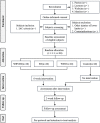Effects of whole-body vibration on sensorimotor deficits and brain plasticity among people with chronic ankle instability: a study protocol for a single-blind randomized controlled trial
- PMID: 37464427
- PMCID: PMC10354978
- DOI: 10.1186/s13102-023-00698-0
Effects of whole-body vibration on sensorimotor deficits and brain plasticity among people with chronic ankle instability: a study protocol for a single-blind randomized controlled trial
Abstract
Background: Chronic ankle instability (CAI) is a form of musculoskeletal disease that can occur after a lateral ankle sprain, and it is characterized by pain, recurrent ankle sprains, a feeling of "giving way" at the ankle joint, and sensorimotor deficits. There has been increasing evidence to suggest that plastic changes in the brain after the initial injury play an important role in CAI. As one modality to treat CAI, whole-body vibration (WBV) has been found to be beneficial for treating the sensorimotor deficits accompanying CAI, but whether these benefits are associated with brain plasticity remains unknown. Therefore, the current study aims to investigate the effect of WBV on sensorimotor deficits and determine its correlation with plastic changes in the brain.
Methods: The present study is a single-blind randomized controlled trial. A total of 80 participants with CAI recruited from the university and local communities will be divided into 4 groups: whole-body vibration and balance training (WBVBT), balance training (BT), whole-body vibration (WBV), and control group. Participants will be given the WBV intervention (25-38 Hz, 1.3-2 mm, 3-time per week, 6-week) supervised by a professional therapist. Primary outcome measures are sensorimotor function including strength, balance, proprioception and functional performance. Brain plasticity will be evaluated by corticomotor excitability, inhibition, and representation of muscles, as measured by transcranial magnetic stimulation. Activation of brain areas will be assessed through functional near-infrared spectroscopy. Secondary outcome measures are self-reported functional outcomes involving the Cumberland Ankle Instability Tool and the Foot and Ankle Ability Measure. All tests will be conducted before and after the WBV intervention, and at 2-week follow-up. Per‑protocol and intention-to-treat analysis will be applied if any participants withdraw.
Discussion: This is the first trial to investigate the role of brain plasticity in sensorimotor changes brought by WBV for individuals with CAI. As plastic changes in the brain have been an increasingly important aspect in CAI, the results of the current study can provide insight into the treatment of CAI from the perspective of brain plasticity.
Trial registration: Chinese Clinical Trial Registry (ChiCTR2300068972); registered on 02 March 2023.
Keywords: Brain plasticity; Chronic ankle instability; Randomized controlled trial; Sensorimotor deficits; Study protocol; Whole-body vibration.
© 2023. The Author(s).
Conflict of interest statement
The authors declare no competing interests.
Figures
Similar articles
-
Motoneuron Function Does not Change Following Whole-Body Vibration in Individuals With Chronic Ankle Instability.J Sport Rehabil. 2019 Aug 1;28(6):614-622. doi: 10.1123/jsr.2017-0364. J Sport Rehabil. 2019. PMID: 30222478
-
Effects of whole body vibration exercise on neuromuscular function for individuals with knee osteoarthritis: study protocol for a randomized controlled trial.Trials. 2017 Sep 20;18(1):437. doi: 10.1186/s13063-017-2170-6. Trials. 2017. PMID: 28931439 Free PMC article. Clinical Trial.
-
Study protocol: the effect of whole body vibration on acute unilateral unstable lateral ankle sprain- a biphasic randomized controlled trial.BMC Musculoskelet Disord. 2013 Jan 14;14:22. doi: 10.1186/1471-2474-14-22. BMC Musculoskelet Disord. 2013. PMID: 23316791 Free PMC article. Clinical Trial.
-
Rebuilding Stability: Exploring the Best Rehabilitation Methods for Chronic Ankle Instability.Sports (Basel). 2024 Oct 17;12(10):282. doi: 10.3390/sports12100282. Sports (Basel). 2024. PMID: 39453248 Free PMC article. Review.
-
Effects of whole-body vibration on chronic ankle instability: a systematic review.Ann Med Surg (Lond). 2023 Nov 21;86(1):401-411. doi: 10.1097/MS9.0000000000001510. eCollection 2024 Jan. Ann Med Surg (Lond). 2023. PMID: 38222746 Free PMC article. Review.
References
-
- Gribble PA, Bleakley CM, Caulfield BM, Docherty CL, Fourchet F, Fong DT, et al. Evidence review for the 2016 international ankle consortium consensus statement on the prevalence, impact and long-term consequences of lateral ankle sprains. Br J Sports Med. 2016;50(24):1496–1505. doi: 10.1136/bjsports-2016-096189. - DOI - PubMed
Grants and funding
LinkOut - more resources
Full Text Sources
Research Materials


